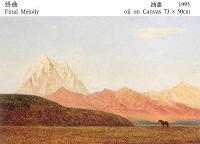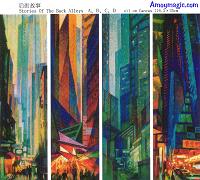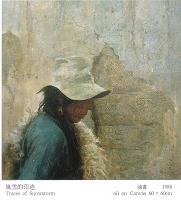![]() Faster
Access Within
China, Click
for Main Menu amoymagic.mts.cn
Faster
Access Within
China, Click
for Main Menu amoymagic.mts.cn
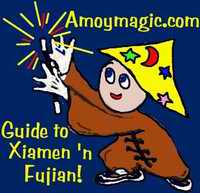
Travel Links![]()
![]() AmoyMagic
(Guide)
AmoyMagic
(Guide)
![]() #1Fujian
Sites!
#1Fujian
Sites!
![]() Quanzhou
(Zayton!)
Quanzhou
(Zayton!)
![]() Zhangzhou
Zhangzhou
![]() Wuyi
Mtn.
Wuyi
Mtn.
![]() Ningde
Ningde
![]() Zhouning
Zhouning
![]() Longyan
Longyan
![]() Sanming
Sanming
![]() Fujian
Foto Album!
Fujian
Foto Album!
![]() MagicFujian
(Guide)
MagicFujian
(Guide)
![]() Travel
Info, Guides
Travel
Info, Guides
![]() Discover
Gulangyu
Discover
Gulangyu
![]() Fujian
Adventure
Fujian
Adventure
![]() Hakka
Roundhouses
Hakka
Roundhouses
![]() Fujian
Bridges
Fujian
Bridges
![]() Order
Books Online
Order
Books Online
![]() Letters
from Readers
Letters
from Readers
![]() A.M.ForumJoin
us!
A.M.ForumJoin
us!![]()
Outside China?
Click Here for Faster Access!
Inside China?
Click Here for faster Access!
Back to Top
AmoyMagic--Guide
to Xiamen & Fujian
Copyright 2006 by Sue Brown & Dr.
Bill, Xiamen Univ.

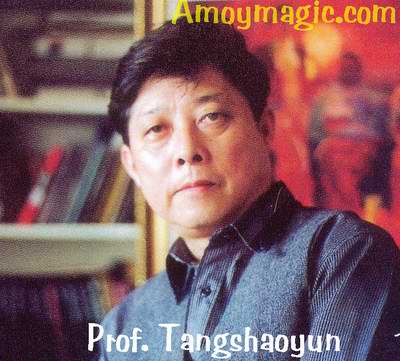
(Click thumbnails below for larger versions)
When I attended an art exhibition by Xiamen UniversityˇŻs Professor Tang Sao Yun, I expected paintings of archetypical Chinese fishermen poling prosaic bamboo rafts past wizened spruce and pagodas perched on cloud covered precipices. I soon found that TangˇŻs works defy pigeonholing as Chinese or Western, classical or contemporary.
TangˇŻs genius is in manifesting the magic of the mundane, in capturing on canvas what we take for granted. In this Tang reminds me of Western literatureˇŻs most famous sleuth, Sherlock Holmes, who once chided his assistant Mr. Watson, ˇ°People see but they donˇŻt observe.ˇ±
I suspected that TangˇŻs rendition of a country road at sunset depicted an exotic locale like Southern France or Wales, but Tang assured me that it was simply the beach road I had cycled down minutes earlier. He explained, ˇ°I often travel this road in the evening to market. I like the moon hovering over the trees, and the gentle glow of street lamps at dusk.ˇ± Tang pointed to a courtyard wall smothered in snarled vines and arthritic tree branches seeking escape from the crowded enclosure. He said softly, ˇ°IˇŻve always wondered who lives behind that wooden gate. It is mysterious.ˇ±
From TangˇŻs perspective the gate was indeed mysterious,
though to my chagrin, during my nine years in Xiamen I had never noticed
either the gate or the wall.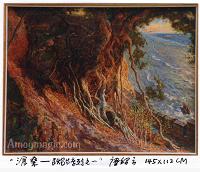
I had also never thought twice about the wizened tree at the ancient Huli fort until I saw TangˇŻs ˇ°Vicissitudes.ˇ± Tang noted the gnarled roots, tangled like a wooden web in their suffocating death grip upon the obstinate boulder, and said, ˇ°The roots resemble Chinese grass-style characters, donˇŻt they? This tree has seen a lot of history.ˇ±
TangˇŻs magic brush had transformed the tenacious tree into an ancient historian who had recorded in roots upon rock the rise and fall of tides and men, of oppression and deliverance. I could almost fancy young scholars sitting at this ancient academicˇŻs feet. I determined to revisit the tree. Perhaps it might speak to me as well?
 While
the Huli tree evokes ChinaˇŻs past, the stately subject of ˇ°Pigeon Whistleˇ±
embodies ChinaˇŻs future. Tang spoke reverently of the tree towering over
the courtyard of his old Beijing apartment, ˇ°This tree is China. She changes
with the seasons, slow or dormant in winter, but in spring, gaining a
new lease on life -- żÝÄľ·ę´ş). Always changing, but ever reaching upward.
While
the Huli tree evokes ChinaˇŻs past, the stately subject of ˇ°Pigeon Whistleˇ±
embodies ChinaˇŻs future. Tang spoke reverently of the tree towering over
the courtyard of his old Beijing apartment, ˇ°This tree is China. She changes
with the seasons, slow or dormant in winter, but in spring, gaining a
new lease on life -- żÝÄľ·ę´ş). Always changing, but ever reaching upward.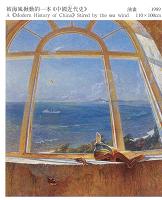
For Tang, even an old nondescript window tells tales. ˇ°A Modern History of China ¨C Stirred by the Sea Windˇ± portrays the harbor through the window of Xiamen UniversityˇŻs old library. On the wooden ledge is a yellowed copy of ˇ°A Modern History of China,ˇ± opened to the chapter on the second opium war. A scholarˇŻs candle drips waxen tears, evoking images of the grievous century of opium trade conducted at gunpoint by foreign ships traveling the now tranquil waters below. Yet this art, like the artist, emanates not melancholy but hope, for as Tang explained, ˇ°The Sea has influenced all changes in modern China, both good and bad. Today, as China opens to the world, most of the influence is good.ˇ± The rising sun of a new day casts beams of golden light upon the window frame, and freighters, not warships, ply the harbor. It is a moving work, and reminds us to learn from the past that we might forge a brighter future.
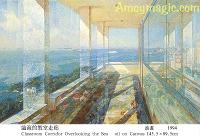 Everyone
does a doubletake at ˇ°The Classroom Corridor Facing the Sea.ˇ± The Xiamen
University Art CollegeˇŻs walls, columns and floors are transparent, allowing
the chimerical architecture to frame the natural beauty rather than detract
from it. Through the ghostly structure one sees the gentle hills rolling
into Xiamen harbor, where boats bob like fishing floats and scenic Gulangyu
Island floats across the port from busy downtown Xiamen. Tang explained,
ˇ°I wasnˇŻt seeking mere realism ¨C a camera or draftsman could do that.ˇ±
Everyone
does a doubletake at ˇ°The Classroom Corridor Facing the Sea.ˇ± The Xiamen
University Art CollegeˇŻs walls, columns and floors are transparent, allowing
the chimerical architecture to frame the natural beauty rather than detract
from it. Through the ghostly structure one sees the gentle hills rolling
into Xiamen harbor, where boats bob like fishing floats and scenic Gulangyu
Island floats across the port from busy downtown Xiamen. Tang explained,
ˇ°I wasnˇŻt seeking mere realism ¨C a camera or draftsman could do that.ˇ±
Tang has a special interest in patriotic art, heedless
of whether ˇ®politicalˇŻ art is in vogue or not. He reminisced with me how
as a child of 3 or 4 he fled with his family before strafing Japanese
bombers, and of his experiences before and after liberation. Like many
Chinese, Tang suffered during the Cultural Revolution, but he emerged
from the tumultuous decade with a more mature appreciation of those who
sacrificed to transform New China from vision into reality.
One such patriotic work, which has been exhibited throughout Asia, is ˇ°Overseas Chinese on the Burma Road during the War of Resistance against Japan.ˇ± Four war-weary but resolute Chinese volunteers stand before a camouflaged truck, the serpentine Burma Road winding into the mountains and clouds behind them. The curved horizon behind the strafing Japanese bomber conveys not only the global proportions of the war but also the pivotal role that overseas ChineseˇŻ sacrifices played for world peace and freedom. As Tang said, ˇ°Without such sacrifices, there would have been no Socialist China as we know her.ˇ±
Tang has also found inspiration from one of New ChinaˇŻs most well known poets -- Mao Ze Dong. The full beauty of Chairman MaoˇŻs poem ˇ°Lou Mountain Passˇ± (¦ɽąŘŁ©could be appreciated only in Chinese until TangˇŻs magic brush transcended language and culture. In this monochromatic study, a horseman blows reveille at daybreak, and the phantasmal outline of soldiers breaks the blanket of morning mist. One can almost hear the stalwart remnant of soldiers as they rub chilled hands and discuss hopes for a decisive victory that morning.
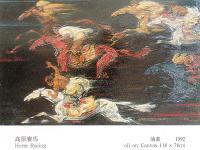 At
56 years young, this vivacious artist enthusiastically embraces many schools
of art but owes allegiance to none, his priority being message, not method.
In ˇ°Plateau Horse Racing,ˇ± lusty stallions painted in violent sweeps of
white, brown and ocher threaten to gallop right off the black wooden frame.
In an impressionist exercise, dollops of bright blues and reds and greens
immortalize the essence of the bougainvillaea that splash our campus with
color year round. An elderly man and woman from TangˇŻs home province of
Sichuan were so lifelike that I could feel their eyes following me curiously,
a shy greeting on the tips of their unmoving tongues.
At
56 years young, this vivacious artist enthusiastically embraces many schools
of art but owes allegiance to none, his priority being message, not method.
In ˇ°Plateau Horse Racing,ˇ± lusty stallions painted in violent sweeps of
white, brown and ocher threaten to gallop right off the black wooden frame.
In an impressionist exercise, dollops of bright blues and reds and greens
immortalize the essence of the bougainvillaea that splash our campus with
color year round. An elderly man and woman from TangˇŻs home province of
Sichuan were so lifelike that I could feel their eyes following me curiously,
a shy greeting on the tips of their unmoving tongues.
Tang said, ˇ°There is much to learn from foreign art, but
we must also take care not to abandon ChinaˇŻs own rich traditions and
techniques.ˇ±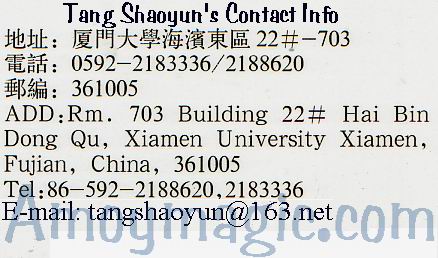
This Sherlock Holmes of the Canvas has given me a greater
appreciation of both Western and Chinese art. And he has motivated me
to observe life, and to internalize what makes this brief sojourn so beautiful
and rewarding -- historian trees, mysterious gates, street lamps at dusk,
a Tibetan child serving butter tea, and the gnarled, gentle hands of my
sonsˇŻ adopted Chinese grandfather.
Dr. William N. Brown
97Äę11ÔÂ18ČŐ
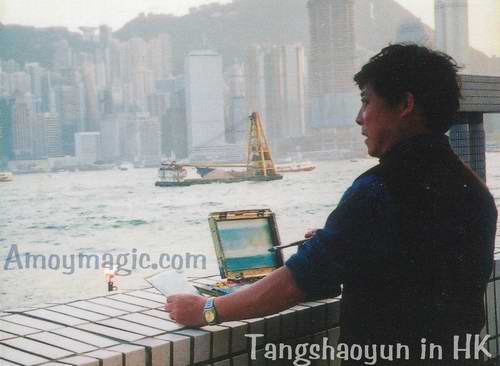 exhibitions
in Hong Kong and Taiwan, as well as the U.S. & Japan. His works were
selected to participate in the 6th, 7th and 8th National China Art Exhibition,
and he won the 2000/2001 Asian Artists Fellowship for the Freeman Foundation
Vermont Studio Center. He has also visited his talented journalist daughter,
Rose, in HK several times, and amassed quite a collection of paintings
of HK.
exhibitions
in Hong Kong and Taiwan, as well as the U.S. & Japan. His works were
selected to participate in the 6th, 7th and 8th National China Art Exhibition,
and he won the 2000/2001 Asian Artists Fellowship for the Freeman Foundation
Vermont Studio Center. He has also visited his talented journalist daughter,
Rose, in HK several times, and amassed quite a collection of paintings
of HK.
Click the Thumbnails below to view more of his paintings!
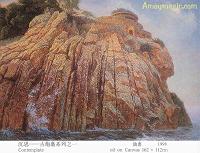
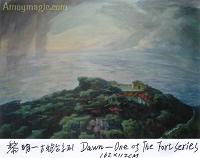

µç»°Łş0592 218 2563
(Please remove the "AT"; this is an anti SPAM measure
to thwart automated e-mail address harvesters)
Last revised: March 29, 2004
Back to Top AmoyMagic Guide to Xiamen and Fujian
Last Updated October 2006
Faster Access
Outside China,
Click
for Main Menu www.Amoymagic.com
![]()
Daily Use Links
![]()
![]() A.M.ForumJoin
us!
A.M.ForumJoin
us!
![]() RealEstate,housing
RealEstate,housing
![]() Restaurants
Restaurants
![]() Hotel
Guide
Hotel
Guide
![]() Shopping
AtoZ
Shopping
AtoZ
![]() Teach
in China!
Teach
in China!
![]() Study
Chinese!
Study
Chinese!
![]() Doing
Business
Doing
Business
![]() Music
Events
Music
Events
![]() Train
Schedule
Train
Schedule
![]() Bus
Schedule
Bus
Schedule
![]() Darwinian
Driving
Darwinian
Driving ![]()
![]() Medical
Care
Medical
Care
![]() Parks
in Xiamen
Parks
in Xiamen
![]() Sports
in Xiamen
Sports
in Xiamen
![]() Bird
Watching
Bird
Watching
![]() Kung
Fu
Kung
Fu
![]() Bushwalks
(Hikes)
Bushwalks
(Hikes)
![]() Museums
in Xiamen
Museums
in Xiamen
![]() History
of Xiamen
History
of Xiamen
![]() Maps
for download
Maps
for download
![]() Translation
Svcs.
Translation
Svcs.
![]() Festival&
Culture
Festival&
Culture
![]() Xiamen
Univ
Xiamen
Univ
![]() Humor&
Humor&![]() Fun
Fotos
Fun
Fotos![]()
![]() Visa
Info
Visa
Info
Misc. Links
![]() Amoy
Tigers
Amoy
Tigers
![]() Chinese
Inventions
Chinese
Inventions
![]() Amoy
People!
Amoy
People! ![]()
![]() Tibet
in 80 Days!
Tibet
in 80 Days!![]()
![]() Dethroned!
To pot?
Dethroned!
To pot?![]()
![]() Misc.Writings
Misc.Writings
![]() Latest
News
Latest
News
![]()
Outside China?
Click Here for Faster Access!
Inside China?
Click Here for Faster Access!
![]() A.M.ForumJoin
us!
A.M.ForumJoin
us!
